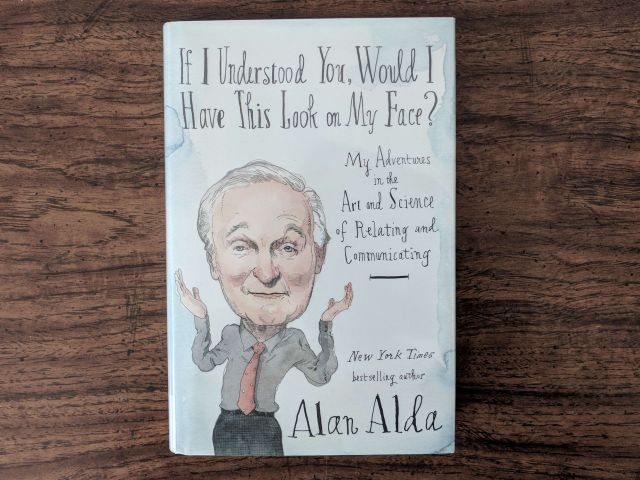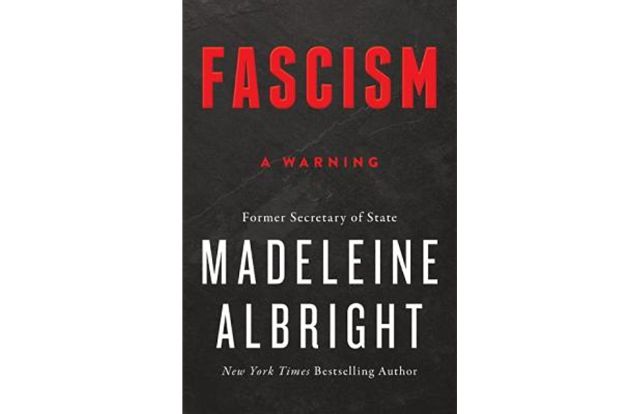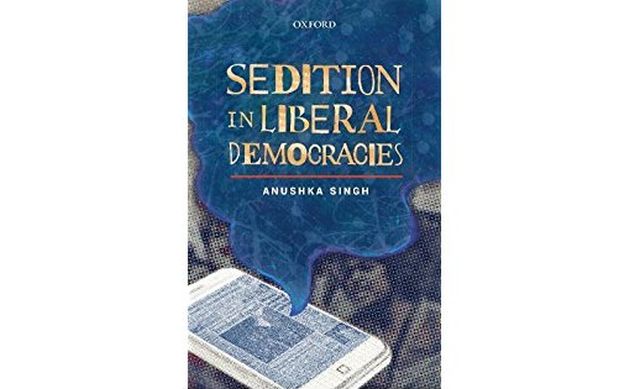
by admin | May 25, 2021 | Books
 By Vikas Datta,
By Vikas Datta,
Title: If I Understood You, Would I Have This Look on My Face?; Author: Alan Alda; Publisher: Random House; Pages: 240; Price: Rs 699
Communication is the basis of human relationships and most of our endeavours. But increasingly, it takes place between scientists and politicians, doctors and patients, businessmen and customers and even husbands and wives without any meaningful result. What are we doing wrong, and why does it matter?
Almost all of our achievements are built on our ability to communicate meaningfully, but it seems we forget this simple fact and talk at each other, rather than to each other.
And then “people are dying because we can’t communicate in ways that allow us to understand one another”, says renowned and award-winning actor, writer and director Alan Alda, adding this may sound like an exaggeration, but is not. As he holds, war is “the most extreme form of poor communication”.
Citing the remark attributed to George Bernard Shaw that “the single-biggest problem in communication is the illusion that it has taken place”, he admits: “When it finally became clear to me that I often didn’t understand what people were telling me, I was on the road to somewhere good.”
Beginning with a practical, painful encounter with his dentist that left him with a sneer — and warned him of the perils of less than clear communication, Alda draws on his experiences, both personal and professional, acting lessons and scientific research to try to tell us how we can bridge the gap to meaningful communication.
Most known for playing “Hawkeye” Pierce in the classic TV series “M*A*S*H 4077”, Alda has also played on stage Nobel-winning physicist Richard Feynmann, who once said that the “real problem in speech is not precise language. The problem is clear language. The desire is to have the idea clearly communicated to the other person…”. Alda shows how we can achieve this goal, by relating better to the other person(s).
Subtitled “My Adventures in the Art and Science of Relating and Communicating”, the book is divided into two parts. In the first, “Relating is Everything”, Alda stresses how relating to the audience (one person or thousands) is important, and its two key attributes — empathy, or responsiveness to what the other might be feeling; and the “theory of mind”, or the ability to anticipate what they are thinking — are the prerequisites of successful communication domestically, professionally and officially.
Both attributes, he contends, are learnable skills and flow from not only hearing — most attentively — what they are speaking, but what their facial expressions, tone of voice, and body language are conveying.
Given his acting background, Alda plumps for innovative and creative exercises in improvisation to help pick up these two skills, relating experiences of classes he, or others, held for various sections, including autistic children.
He combines this with scientific research on various aspects of this human behaviour as well as his own attempts, including meditating, reading fiction and identifying emotions of passers-by on the street or otherwise.
In the second section, “Getting Better at Reading Others”, he elaborates on these two traits and their learning but also points out the hindrances, especially jargon and “the curse of knowledge” (“Once we know something, it’s hard to unknow it, to remember what’s it like to be a beginner…”) and how empathy is not always beneficial.
The book is packed with singular anecdotes, cutting edge-research and interesting — and unexpected — insights, (eg, “when men share the housework with their wives, it leads to more sex”), it is all delivered in a conversational, candid, witty and self-deprecating manner (like most of his screen roles; Hawkeye Pierce once asserted that he “thrives on rejection”).
But overall, Alda makes a convincing case for (relatively) small but key things that can enable us to convey our message for mutual benefit. One complaint may be that it is too repetitive with him belabouring the same point again and again, but then he is stressing on some of the most obvious things we miss.
We won’t lose much by trying what we suggests. What we may gain may be beyond estimation.
(Vikas Datta can be contacted at vikas.d@ians.in)
—IANS

by admin | May 25, 2021 | Books
 By Nivedita Singh,
By Nivedita Singh,
Title: Treasures: Allahabad Museum, Allahabad; Author: Malavika Singh, Rajesh Purohit; Publisher: Niyogi Books; Pages: 190; Price: Rs 995
Enjoying rare books in a museum is common, but you can now enjoy the Allahabad Museum through a book – “Treasures”, which lists its assets and recounts its history.
Part of an initiative by the Ministry of Culture’s Museum Reforms Programme, the book highlights the many treasures of the museum, which has a rich and diversified collection of art, antiquities, paintings, sculptures, coins, ceramics, archaeological objects, illustrated manuscripts, decorative art objects, arms and armour, textiles, natural history specimens, photographs, prints and personal collections.
Located in the Civil Lines area, the heart of the Allahabad city, the museum was first inaugurated in 1878. “For unforeseen reasons, the museum closed down in 1881,” the book says.
It was reopened in 1931, but its turning point came in 1986.
“Realising the significance of the diversity of its archaeological artefacts, the museum was taken over by the Ministry of Culture, Government of India, after constituting an autonomous body called Allahabad Museum Society, and it was declared a museum of national importance,” the book says.
The artefacts in the museum are displayed in 16 different galleries, including an exhibition in the Memorial Hall.
“Treasures, of Indian Museums, is a series that reflects the aesthetic sensibilities of Indian artists and their patrons, through the ages. Indian art is rooted in different philosophies. This series of museum publications aims to share this extraordinary repository with the world,” Union Culture Minister Mahesh Sharma says in a message in the book.
The book contains information on the date and provenance, as well as a brief introduction of each object. There are, for instance, over 200 weapons in the Allahabad Museum, some of them from as far back as the 17th century. Among them is a light machine gun from the First World War.
The Museum also has a vast collection of items related to the freedom struggle. There is the pistol that Chandrashekhar Azad used in his last shootout with the British police in Allahabad in 1931, in which he died, and a collection of photographs starting from the first war of independence in 1857 to the country’s independence in 1947. It also has in its possession the sword and costume of Maulvi Liaquat Ali Khan of Allahabad, one of the heroes of the 1857 battle.
The brass casket in which Gandhi’s ashes were taken to the Sangam in Allahabad is also displayed. The large Ford lorry used to haul the cortege carrying Gandhi’s ashes for immersion in the Sangam is parked outside the museum. It’s in perfect working condition — and retraces the journey every year on February 12.
Among the other rare collections at the museum are coins from various dynasties, including those of Kanishka 1 (1st Century), Septimus (2nd Century), Samudra Gupta (4th Century), Chandra Gupta (4th Century) and Akbar (16th Century). A fair number of Mughal paintings from Delhi and Lucknow — the principal centre of Mughal art — are also displayed in the museum.
“All the schools of Rajasthani art are represented in the museum — including Buni, Malwa, Mewar, Jaipur, Jodhpur, Nathdwara and Kishangarh,” the book says, adding that a rich collection of the Bengal School of paintings is also a part, along with 19 works of Russian painter and philosopher Nicholas Roerich.
(Nivedita Singh can be contacted at nivedita.singh@ians.in)
—IANS

by admin | May 25, 2021 | Books
 By Vikas Datta,
By Vikas Datta,
Title: Fascism: A Warning; Author: Madeleine Albright; Publisher: William Collins; Pages: 304; Price: Rs 699
If not the outcome of the Second World War, the Berlin Wall’s fall seemed to pave the way for democracy’s triumph — but nearly three decades later, we may be forced to rethink this comforting thought. The recent growth of authoritarianism, emphasising “tradition” and conformity and villifying globalisation, immigration and dissent are pointers that fascism is certainly not in the “dustbin of history”.
We have long thought that it was the 20th century which saw the global clash between democracy and fascism, where the latter was defeated. But, as we find in this book, this defeat was far from conclusive and fascism never ever really went away — and certainly not far enough.
Fascism existed even in the traditional homelands of democracy, where it still could come out most unexpectedly — as the Brexit vote and the election of Donald Trump shows, contends former US Secretary of State Madeleine Albright in this book.
Asking why democracy “is under assault and in retreat” (as per Freedom House), why so many people in power are “seeking to undermine public confidence in elections, the courts, the media, and — on the fundamental question of earth’s future — science”, why differences are widening and, ultimately, why we are once again talking about Fascism, she gives an unequivocal answer — the current US President.
“One reason, frankly, is Donald Trump. If we think of fascism as a wound from the past that had almost healed, putting Trump in the White House was like ripping off the bandage and picking at the scab,” says the first woman to be Secretary of State — and then seeks to make her case.
But this is far from just another anti-Trump rant, no matter how elegantly phrased, and not only focussed on him.
For in this a timely, informative and frankly worrying account and analysis, Albright travels from the original fascist, Benito Mussolini and his Nazi contemporary Adolf Hitler to Slobodan Milosevic’s Serbia; from the “Hermit Kingdom” of North Korea under the Kims and Hugo Chavez’s Venezuela, and from Russia in its Soviet phase under Stalin (and now under Vladimir Putin) to Recep Tayyep Erdogan’s Turkey and Viktor Orban’s Hungary.
However, she does not term all of these as fascist, but instead shows how some of their actions tend towards fascism and which ones may be misguided or wrong but aren’t fascist.
And Albright, who had suffered under fascism twice — with one version engulfing her homeland and a large part of her family, and then another from the opposite direction made them refugees again — also seeks to analyse fascism’s pathology, why we fail to recognise it, or most importantly, why a lot of us are persuaded by it.
Answering the second question first, she contends nothing beats fascism as the ultimate political pejorative — used for any corporate bigwig by a leftist, for Barack Obama by those of the far-right, for strict parents by any rebellious teen, as well as for teachers, feminists, chauvinists, yoga instructors, police, dieters and many more.
However all this overuse is “draining potency from what should be a powerful term”, and hence blinding us to its ominous presence, she says.
Albright then goes on to identify what fascism is really and how to recognise its adherents. She delineates the tactics of its leadership, which span drawing on resentments to the desire to be part of a bigger, powerful whole, and how they consolidate power, chiefly by seeking to control information, to arrive at a definition of fascism and tracing its origins in the modern, industrialised world.
Along with the case studies mentioned above, including her own interactions with most of the contemporary figures listed here, she goes on to present an alarming set of futures for the US under Trump (and beyond), why people get disenchanted with democracy, the less than salutary role of social media and big business to make some incisive points about fascism and how we can — and should — tackle it.
Albright says no country or society, no matter how much it prides itself on its democratic traditions, can remain immune, given the changing political and economic dynamics.
We can only be prepared to recognise the warning signs and this shows how.
(Vikas Datta can be contacted at vikas.d@ians.in )
—IANS

by admin | May 25, 2021 | Books
 By Saket Suman,
By Saket Suman,
Book: Sedition In Liberal Democracies; Author: Anushka Singh; Publisher: Oxford University Press; Pages: 391; Price: Rs 995
This recent offering sets out to examine the relationship between liberal democracies and sedition. At the onset, the author traces the history of sedition laws and then goes on to examine it in the context of free speech and democratic ethics. Comparisons are then made between her findings from fieldwork in Haryana, Maharashtra and Delhi — and perspectives from England, the US and Australia.
What emerges is a well-researched documentation of how sedition laws are currently being used in India and its implications for free speech and the spirit of a liberal democracy.
The author, an assistant professor at the School of Law, Governance and Citizenship, Ambedkar University, opens the book with a February 1, 2017, incident at the University of California-Berkeley where mob violence erupted on campus with 1,500 protesters demanding the cancellation of a lecture by Milo Yiannopoulos. The British author, notorious for his “racist and anti-Islamic views”, was ultimately forbidden from delivering his public lecture.
This led to “a chain of reactions on desirability and limits of freedom of expression within American democracy — the Left-leaning intellectuals and politicians were accused of allowing mob violence while the cancellation of Yiannopoulos’ lecture also conveyed that only liberals had the right to free speech”.
Singh then shifts her focus to 2016 in India when “a series of criminal cases were registered involving the act of sloganeering in support of the right to self-determination of people in Kashmir”. She elaborates at length on the fiasco that unfolded at Jawaharlal Nehru University (JNU) after some of its student leaders were charged and arrested for sedition. But what leads Singh to draw a comparison between Berkeley incident and what happened at JNU?
“The incident at Berkeley,” she elaborates, “presents… a case, in which restrictions on free speech was demanded and justified in the name of protecting what is largely called the ‘liberal-democratic’ values from illiberal political opinions. In the Indian case, however, the restriction on the right to freedom of expression of individuals was justified in the name of coagulating state security”.
These two separate incidents that took place in two different countries serve as the two pillars on which the larger framework of “Sedition In Liberal Democracies” is placed — the debate over the centrality of free speech and restrictions on the same. The author is quick to remind us that these concerns gain prominence only in liberal democracies as an authoritarian state does not recognise the individual as “a right-bearing citizen” and therefore “is inappropriate for any debate on freedom to take place”.
So how does the author describe a liberal democracy? “A fraught combination of competing tendencies and traditions, since it attempts to bring together liberalism and democracy, on the one hand, and the imperatives of democracy and the state, on the other.”
The book largely deals with those forms of expressions within liberal democracies that are uttered against the authority of the state. The state of freedom of expression that citizens have against the authority therefore becomes crucial.
A scholarly offering, which has been sufficiently footnoted and carries a Bibliography section, is ideal for anybody who wishes to delve deeper into the very concept of liberal democracies and understand how the concept of sedition is different on paper than how it is perceived by citizens or applied by authorities. The book looks at sedition laws in its current form and uses it as a lens to probe the fate of political speech in liberal democracies.
(Saket Suman can be contacted at saket.s@ians.in)
—IANS

by admin | May 25, 2021 | Books
 By Vikas Datta,
By Vikas Datta,
Title: Death at the Durbar; Author: Arjun Raj Gaind; Publisher: HarperCollins India; Pages: 368; Price: Rs 399
It is India in 1911 — the Raj’s high-point, with the King Emperor setting foot in his prized dominion for the first time. The colonial administration is sparing no efforts to mount a grand Coronation Durbar where India’s princes will pay him homage. But a dead “nautch” girl hanging in the royal residence was certainly not part of the arrangements.
With the British monarch arriving the day after the next, the authorities have limited time to solve the crime, and more importantly, ascertain if it portends any threat to his life. Involving police seems the obvious step, but in light of the simmering discontent and fear of the incident leaking and casting a scandalous shadow over the grand event, they take a gamble.
On advice of royal ADC Malik Umar Hayat Khan, the Viceroy, Lord Hardinge, summons Sikander Singh, the Maharajah of Rajpore (in the Punjab) and an amateur detective, to solve the mystery — within 24 hours.
Though our hero is put out by the peremptory way he had been called and how some officials — especially the upcoming Michael O’Dwyer — are not enthused by his involvement (though Punjab Lt Governor Sir Louis William Dane is supportive), he is not one to skip such a challenge.
The stage is thus set for the stirring second installment of “The Maharaja Mysteries” by Arjun Raj Gaind, who moved from graphic novels to the equally promising, though thoroughly underutilised, area of Princely India and its crimes.
And in His Highness Farzand-e-Khas-i-Daulat-i-Inglishia, Mansur-e-Zaman…or, simply, Sikander, he has a worthy protagonist, with a keen intellect and interests beyond wealth, women and wine.
“Gold he was content to leave to the Nizam of Hyderabad, wine to the Gaekwad boys, polo ponies to his cousin Bhupinder of Patiala, and fast women to his dearest friend, Jagatjit of Kapurthala”, but mysteries are something Sikander cannot resist.
But after identifying the victim as a dancing girl, the circumstances of the murder and some traits of the probable murderer, he will not have an easy time of it.
For he learns the girl was brought to the camp as a “gift” for the King by the Maharaja of Kapurthala, and her last visitors included the Nizam, the Maharajas of Patiala, Alwar and Gwalior, the dowager Maharani of Bharatpur, a British journalist, and, “unofficially”, a messenger from the Maharaja of Kashmir, an Indian who said he was her uncle, as well as two British ladies.
While the prospect of questioning all these potentates — who outrank him in honour and protocol many times over — and others is daunting, Sikander also has to handle British officer Capt Arthur Campbell, attached to him to “aid” him, investigate a group of high British officials’ wayward sons, and negotiate among the conflicting advice he gets from two peers (the Maharajas of Bikaner and Baroda).
But even with the time constraints, will our princely detective be allowed to operate freely to find the culprit, or will other considerations, chiefly political, prevail?
Find out in Gaind’s masterful evocation of a glorious, bygone era with a host of larger-than-life characters, especially the Maharajas, who span both saints and scoundrels, demonstrate both parsimony and profligacy, and are fervent British loyalists or principled Indian nationalists.
Though the engrossing mystery has a rather tame denouement and a mistake or typo or two (Nadir Shah invaded India in 1730, not 1540), the real value is in the atmosphere — of a different Delhi in both time and space — and characterisation, especially of the princes with their idiosyncrasies or darker sides.
There is the Nizam, who, offered a cigarette, insists on taking the case too, intelligent minds like Ganga Singh of Bikaner or Sayaji Rao Gaekwad of Baroda, twisted, violent minds like Jey Singh of Alwar and Tukoji Holkar of Indore, Kashmir’s scheming regent, the redoubtable Maharani of Bharatpur, who, Gaind regrets, history has neglected, the lovelorn Jagatjit or Jitendra Narayan of Cooch Behar and many more.
Complementing them are a range of British officials with a equally wide gamut of perspectives towards India and Indians — sympathy, tolerance, indifference and repugnance.
In all, it makes for a heady cocktail — and there are many points left hanging for the next installment, which we hope will come soonest.
(Vikas Datta can be contacted at vikas.d@ians.in )
—IANS





